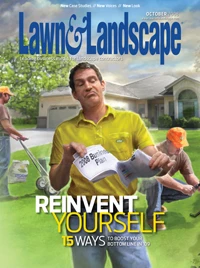As America faces extensive, ongoing water shortages, contractors have begun partnering with clients to provide a necessary service: efficient irrigation.
“In the next decade, 38 states will have a water crisis,” says Rich Bradley, president of Superscape Landscape Management Corp. in East Falmouth, Mass. “Irrigation and landscape people need to start doing the right thing in the efficient use of water and green building. We’re caretakers of the environment.”
Successful irrigation specialists say that while there are challenges involved in starting an irrigation service, it ultimately reaps returns on the investment of time, labor and equipment.
For example, half of Bradley’s $700,000 annual revenue comes from irrigation (his irrigation customer base is 20 percent commercial, 80 percent residential). Bradley’s company provides full irrigation and landscaping services, including design, installation and maintenance, as well as hardscapes and hydroseeding. He has four full-time employees, with part-time help added as necessary.
Likewise, nearly 40 percent of Rick Hayden’s $600,000 annual revenue comes from irrigation. Hayden, the second-generation owner of Hayden Landscaping in Greenup, Ill., added irrigation to his services in the late 1980s when he noticed he was losing commercial jobs to companies providing the service. Nearly 90 percent of his irrigation work is in the residential sector.
Hayden Landscaping provides landscape and irrigation services including design, installation and maintenance, as well as retaining walls, patios, sidewalks, seeding and sodding. Overall, the company’s workload is 70 percent residential, 30 percent commercial and municipal.
Peter Nedwick generates between $500,000 and $1 million in annual revenue through his full-service irrigation company, P&P Sprinkler in Burlingame, Calif., which services residential and light commercial sectors. Peter Nedwick’s wife, Patty, runs the office; he tends to field work with another full-time employee and two part-time workers. Services include wire and valve locating, wire tracking, repair, upgrades, automation, replacement, design, water auditing and smart irrigation controls.
study for success
Those who’ve incorporated irrigation services successfully offer these ideas.
• First and foremost, make sure your business is adequately capitalized.
• Educate yourself. Hayden, who operates in five states, points out permits and licensing varies from state to state. There was nowhere to learn the trade when Peter Nedwick started 28 years ago, so he turned to a plumber to learn plumbing and hydraulics, picking up the rest as he went along.
Today’s contractors have more options: Hayden took seminars from a Toro distributor and spoke with other irrigation equipment manufacturers. Bradley points out opportunities also are available through local associations, the Irrigation Association and through the U.S. Environmental Protection Agency’s Water Sense program, in which he’s a partner.
• Train your employees. It takes a few years to develop a technician with skills good enough to handle all service calls, Hayden says.
• Engage in ongoing education in response to emerging technologies. The self-taught Peter Nedwick now continues his education through the California Landscape Contractors Association, the Irrigation Association and seminars offered by Ewing Education Services and other supply houses. Patty Nedwick credits Ewing’s seminars with “providing contractors the tools to provide better service and state-of-the-art technology to our clients.”
Improperly trained contractors will find success difficult, points out Bradley, certified as a landscape professional, designer, golf course auditor and contractor. “I see it every day on a system someone else has put in,” Bradley says. “It’s a mess and it ends up costing the homeowner three times to get it fixed as it did to put it in. Commercial work is another ballgame - guys will try to tackle a commercial job that’s way over their heads.
“Many irrigation guys don’t understand how plants work,” he adds. “On the flip side, a lot of landscape guys get involved in irrigation and don’t understand how irrigation works. They put the rotors and spray heads on the same zone or water plants at the same time. Different plants, turfs, perennials, and shrubs require different amounts of water. They try to do it all together to get it the cheapest way, but it’s not the most beneficial way for the plants.”
• Maintain inventory. Peter Nedwick’s trucks carry a small amount of various products in different sizes. But don’t carry too much, he adds. “If you’re buying more materials than you’re putting in, that’s not good,” Peter Nedwick says. “Before we go to the supply house, we make sure we don’t already have it on the shelf. We keep track of what’s sold and what isn’t.”
The biggest upfront cost is installation equipment, Hayden says. Usually, he uses a pipe puller rather than a trencher.
As business grows, contractors should add a dedicated utility truck for carrying supplies, Hayden adds.
Overcome obstacles
One of the challenges in starting an irrigation service is finding competent employees. “It’s really hard to find the right service people who will engage the customer and fix the complaint right the first time,” says Nedwick.
Hayden has found what deters people in his region from installing an irrigation system is not its cost, but the cost of the water it takes to run it. “Whatever they pay for water, they also pay for sewer,” he says.
Hayden’s company teaches customers to run their systems more efficiently by not running 20 minutes per zone once daily, but running during an extended timeframe to give it time to soak in.
Building a business from scratch in order to establish a reputation also is a challenge, Peter Nedwick says.
“The biggest challenge is to build the business, generate cash and supply people with the products they want,” he says.
His company’s strategy: “We call people back, we’re on time and we have what we need when we get there.”
Figuring out his market was difficult; he eventually targeted residential and light commercial market.
Get ‘smart’
Water efficiency is a key factor in installing today’s irrigation systems.
“More people are concerned not only with saving water, but saving money by saving water,” Hayden says. “Going green is catching on.”
Although there is no water shortage in his region, residents are still concerned about water waste, he says. To create efficiencies, his does preventative maintenance, ensuring correct head and nozzle positioning.
Water efficiency can be accomplished through smart controllers, coupled with good design, installation and maintenance, Bradley says.
“If you repair a sprinkler head and put on the wrong head or nozzle, it’s going to throw the efficiencies off,” he says, adding he uses multi-stream MP rotators.
Peter Nedwick conducts water audits, a service that’s becoming more in demand.
Eventually, ‘smart’ irrigation may go from an option to a mandate. California municipalities require that smart controllers replace failed ones by 2012.
“You’ve got to also be smart about your irrigation layout,” Peter Nedwick says. “You’re not going to see anything other than smart controllers manufactured after 2012. The technology is rapidly changing and getting better.”
Rain and moisture sensors are popular among Hayden’s clients.
Other ‘smart’ technologies include smart sprinkler controllers that can be programmed to schedule the irrigation based on real-time weather patterns and landscaping conditions. Historical norms are programmed into the weather station. The property’s latitude and longitude data is entered. The controller calculates its position, measures the UV light and other factors such as evapotranspiration (ET), plantings, exposure and soil conditions.
Focus on customers
Customers have to be educated on how new technologies work or what upgrades they may need.
“You have to find out how they want their irrigation system to work for them and provide that,” Peter Nedwick says.
Peter Nedwick further focuses on customer satisfaction by calling if he’s going to be late and attempting to minimize callbacks.
“We can’t always do it right the first time because there are variables, especially when you’re working on galvanized pipe that’s been in the ground for 50 years or longer,” he says. “You can fix a leak in a pipe and two feet over, there’s another. It’s a callback.”
In creating cost efficiencies, Peter Nedwick ensures trucks are stocked with required parts as to avoid unnecessary trips back to the office. Like others, he’s keen on route optimization: grouping service calls in a specific geographic region to save on high fuel costs and time.
Knowing one’s costs is important in setting prices, says Bradley. “You’ve got to know how long it takes to install a system,” he says. “A lot of people price work by the zone. One zone might have four heads; another might have 30. Obviously the one with more heads is going to cost more to install, so you charge by the head.”
Nedwick also saves time by using a quick clip and bolt-on saddle.
He schedules for efficiency as well: The month’s contract jobs are posted on a board and service work fills in remaining slots. With a quick glance, parts can be ordered in advance.
Irrigation work involves emergency calls that push back Nedwick’s service calls until he’s caught up.
Irrigation contractors must watch for underground pipes and wires during installation, especially in regions where the water table is high and underground utilities are not buried deeply. Some contractors contact a utility-locating organization or ask property owners the location of sewer, septic and landscape lighting lines.
Spread the word
Marketing an irrigation business is important, says Patty Nedwick. She’s retooling the company’s brochures to emphasize services such as smart controllers, weather stations and water auditing, targeted established clients as well as potential ones.
“Several of our communities’ properties are worth millions of dollars. If we face water rationing next year, they’re not going to want to lose their landscaping,” she says.
Whether a landscape company gets into irrigation depends on several factors, says Hayden.
“You’ve got to be able to devote time and resources to it,” he says. “The market plays a big influence. Right now, they’re not building new houses. It’s not something to consider in a rural area, but it’s worth it in places like Chicago area where there are smaller lawns. It’s worth it in an established lawn and landscape maintenance-oriented business.”
Nedwick says irrigation is not a good fit if the main thrust of one’s business is gardening or horticulture.
“Over the last 20-some years, I’ve learned about plants, but I’m not a horticulturist,” he says. “If you’re not going to be an irrigation guy and a plumber - because basically this is outdoor plumbing – then don’t do it. It’s wet, it’s dirty, you need to know plumbing and electrical, your products – such as sprayers, gear-driven heads, MP rotators, valves and drip irrigation - and how it all works together and put on whatever schedule is needed.”
Ultimately, there is a market for irrigation, especially smart irrigation, Nedwick points out.
“People get excited about this stuff,” he says. “They want to save water and be ahead of the curve.”
Get curated news on YOUR industry.
Enter your email to receive our newsletters.
Explore the October 2008 Issue
Check out more from this issue and find your next story to read.
Latest from Lawn & Landscape
- Mariani Premier Group acquires Hazeltine Nurseries
- EnP Investments adds Mark McCarel as Northeast territory sales manager
- Our April issue is now live
- Ready or not
- Tribute to an industry guru
- Caterpillar names Christy Pambianchi as chief human resources officer
- Ceramica acquires Fundraising Brick
- Senske Family of Companies acquires Huron Pest Control






